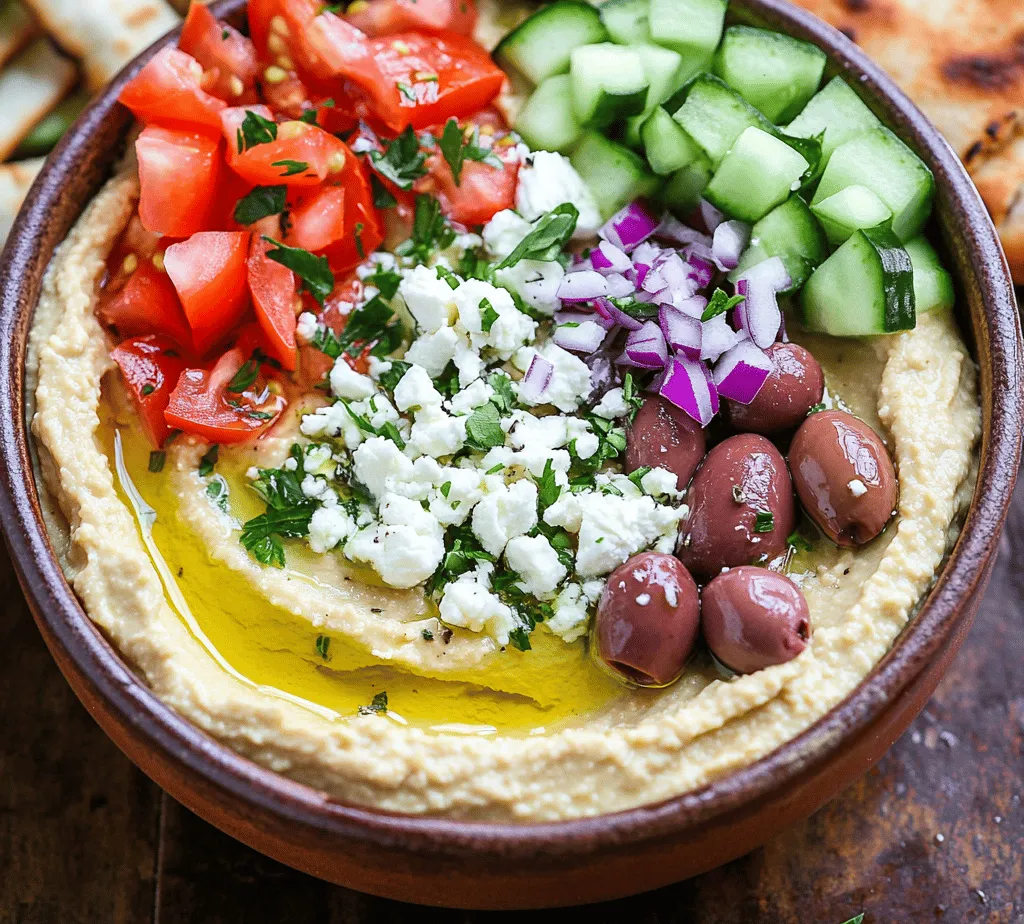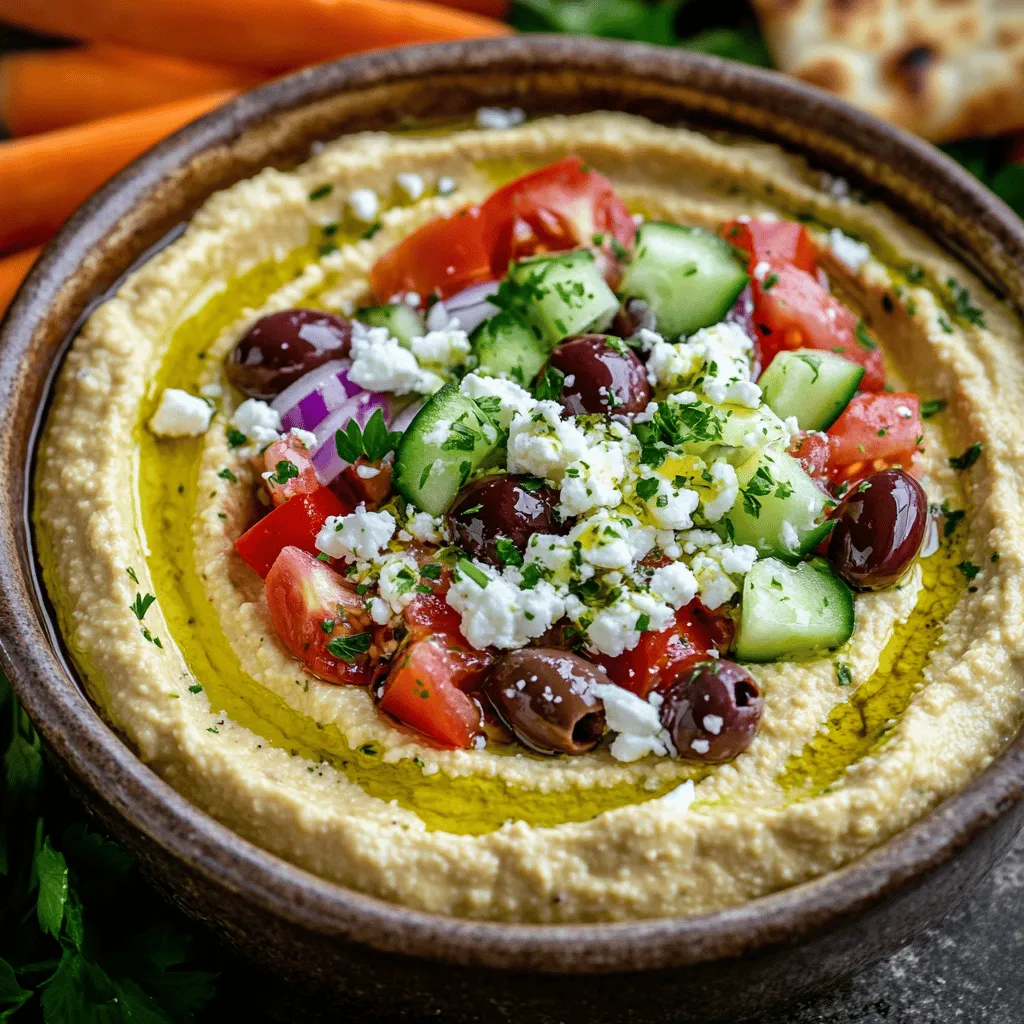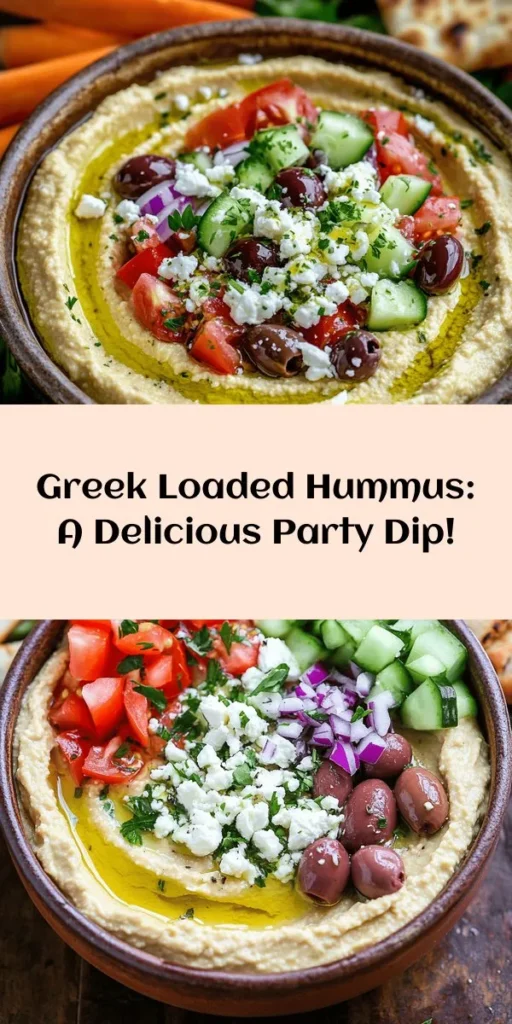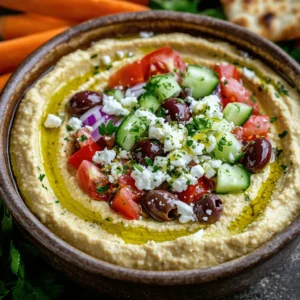Introduction
In the realm of dips, few can rival the creamy delight and versatility of hummus. Among its many variations, Greek Style Loaded Hummus stands out as a vibrant and flavorful dish that embodies the spirit of Mediterranean cuisine. Originating from the heart of Greece, this dish is a perfect representation of the region’s culinary heritage, bringing together fresh ingredients and bold flavors. Hummus is not just a dip; it is a cultural symbol, an appetizer that brings people together around the table, and a testament to the Mediterranean way of life that celebrates health and community.
As hummus gains popularity across the globe, it has transitioned from a traditional Middle Eastern staple to a favorite in kitchens everywhere. This loaded version takes the classic chickpea dip and elevates it with a myriad of toppings, making it not only more visually appealing but also richer in flavor and texture. In addition to being delicious, hummus is packed with health benefits, making it a guilt-free indulgence. It is high in protein and fiber, low in calories, and offers a wealth of vitamins and minerals.
In this article, we will delve into the recipe for Greek Style Loaded Hummus, guiding you through the essential ingredients, preparation steps, and presentation tips that will make your hummus the star of any gathering.
The Essence of Greek Cuisine
Greek cuisine is a celebration of flavors, colors, and textures, rooted in the Mediterranean diet that emphasizes fresh, wholesome ingredients. At its core, Greek culinary traditions revolve around the consumption of fruits, vegetables, whole grains, legumes, and healthy fats, particularly olive oil. These ingredients not only tantalize the taste buds but also contribute to a balanced and healthful diet.
A defining characteristic of Greek cuisine is the importance of seasonal and locally sourced produce. Fresh vegetables, such as tomatoes, cucumbers, and bell peppers, are staples in many Greek dishes, contributing vibrant colors and essential nutrients. Legumes, including lentils and chickpeas, are foundational for protein-rich meals, making them ideal for both vegetarians and meat lovers alike.
Hummus, with its smooth texture and nutty flavor, has become a beloved appetizer in Greek cuisine—often served as a mezze alongside other small dishes. Each region in Greece boasts its unique take on hummus, whether it be through the choice of spices, additional toppings, or serving styles. In coastal areas, you may find hummus paired with fresh seafood, while in the mountains, it might be accompanied by robust, earthy breads.
The loaded version of hummus offers a canvas for creativity, allowing you to explore various toppings and flavor combinations that reflect your personal taste while honoring the traditional roots of Greek cuisine.
Ingredients Breakdown
Creating the perfect Greek Style Loaded Hummus starts with understanding the ingredients that contribute to its deliciousness. Each component plays a critical role in achieving the right flavor profile and texture. Here’s a comprehensive breakdown of the key ingredients used in this recipe:
Chickpeas
Chickpeas, or garbanzo beans, are the foundation of hummus. These legumes are not only rich in protein but also provide an excellent source of dietary fiber, which aids in digestion and helps maintain satiety. Packed with essential vitamins and minerals, including folate, iron, and magnesium, chickpeas are a powerhouse of nutrition. When blended, they create a creamy base that is both satisfying and versatile, making hummus a go-to dip for many.
Tahini
Tahini is a paste made from ground sesame seeds and is crucial for achieving the authentic flavor and texture of hummus. This ingredient contributes a rich, nutty flavor and a creamy consistency, enhancing the overall dish. Nutritionally, tahini is a good source of healthy fats, protein, and a range of vitamins, including B vitamins and vitamin E. It also contains minerals such as calcium, magnesium, and phosphorus, making it a valuable addition to your diet.
Olive Oil
Olive oil is a quintessential element of Greek cuisine, known for its health benefits and distinct flavor. It is rich in monounsaturated fats, which are linked to heart health, and has anti-inflammatory properties. When selecting olive oil for your hummus, opt for high-quality extra virgin olive oil, which offers a robust flavor and aroma. The oil can be drizzled on top of the hummus before serving, creating a beautiful sheen and enhancing the overall taste.
Fresh Lemon Juice
Fresh lemon juice is essential for balancing the flavors in hummus. Its acidity brightens the dish, cutting through the richness of the tahini and olive oil. Lemon juice not only adds a refreshing tang but also provides a dose of vitamin C and antioxidants. It is advisable to use freshly squeezed lemon juice for the best flavor; pre-packaged lemon juice often lacks the bright, zesty quality that fresh juice offers.
Garlic
Garlic is another key ingredient in hummus that contributes both flavor and health benefits. Known for its anti-inflammatory and immune-boosting properties, garlic adds a pungent, savory note to the dip. The amount of garlic used can be adjusted based on personal preference; some may prefer a more subdued flavor, while others might enjoy a robust garlic presence.
Ground Cumin
Ground cumin is a spice that adds warmth and depth to the hummus. Its earthy flavor complements the nuttiness of the tahini and the creaminess of the chickpeas, creating a well-rounded taste. Cumin is also known for its potential digestive benefits and is often used in Mediterranean and Middle Eastern cuisine.
Fresh Vegetables
Fresh vegetables play a vital role in the presentation and flavor of Greek Style Loaded Hummus. Crisp cucumbers and juicy tomatoes are often used as toppings, adding color and crunch. These vegetables not only enhance the visual appeal of the dish but also contribute additional nutrients and freshness, making each bite more enjoyable.
Kalamata Olives
Kalamata olives are a classic ingredient in Greek dishes and are known for their rich, briny flavor. Adding chopped Kalamata olives to your hummus brings a savory kick that pairs beautifully with the creamy elements of the dish. These olives are also a great source of healthy fats and antioxidants, making them a nutritious topping.
Feta Cheese
Feta cheese is a staple in Greek cuisine, known for its tangy flavor and crumbly texture. Crumbling feta over the hummus not only adds a burst of flavor but also enhances the dish’s creaminess. Feta is rich in calcium and protein, making it a delightful addition that elevates the overall experience of the hummus.
Fresh Herbs
Fresh herbs, particularly parsley, play a significant role in enhancing both the flavor and presentation of Greek Style Loaded Hummus. Chopped parsley adds a pop of color and a refreshing herbaceous note, balancing the richness of the other ingredients. Herbs are often used in Mediterranean cooking to add freshness and complexity to dishes.
Pita Bread and Vegetable Sticks
To serve your Greek Style Loaded Hummus, consider pairing it with warm pita bread and an assortment of vegetable sticks. Pita chips or sliced vegetables such as carrots, celery, and bell peppers serve as the perfect vehicles for scooping up the creamy hummus. These options not only offer a satisfying crunch but also provide a healthy way to enjoy the dip.
As we move forward, we will guide you through the preparation steps to create this delightful dish, ensuring you can savor the rich flavors of Greek Style Loaded Hummus in your own kitchen. Stay tuned for the next part, where we will dive into the preparation process and tips for presentation that will impress your guests.




